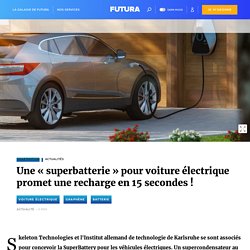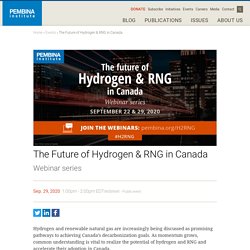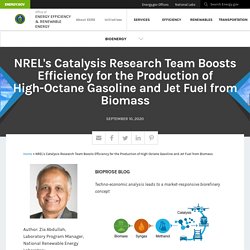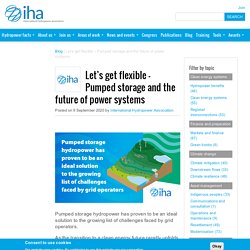

Www.wsj. Harnessing the power of hydrogen in Canada. Canada’s largest hydrogen blending project will soon be under construction in Fort Saskatchewan, Alberta, Canada, injecting up to 5% hydrogen by volume into a section of the city’s residential natural gas distribution network to approximately 5,000 customers.

The milestone project will be led by Canadian Utilities, a member of the ATCO Group of companies. Involved in innovation focused on sustainability and carbon reduction for many years, Canadian Utilities has now identified hydrogen as the pathway to reuse and decarbonise Canada’s gas energy infrastructure, pioneering the clean energy solutions’ tremendous potential. “Blending hydrogen into natural gas reduces the greenhouse gas intensity of the natural gas stream, as the combustion of hydrogen emits only water. World’s largest solar plant goes online in China. Making Mission Possible: Delivering a Net-Zero Economy. Une « superbatterie » pour voiture électrique promet une recharge en 15 secondes !
Skeleton Technologies et l'Institut allemand de technologie de Karlsruhe se sont associés pour concevoir la SuperBattery pour les véhicules électriques.

Un supercondensateur au graphène qui promet un temps de charge de 15 secondes pour les batteries au lithium. Cela vous intéressera aussi [EN VIDÉO] Les étonnantes propriétés quantiques du graphène Le graphène est un matériau composé d’une seule couche d’atomes de carbone. Il a notamment des propriétés électriques étonnantes.
Découvrez en vidéo, grâce à Tout Est Quantique, les secrets du graphène. Découvert il y a une quinzaine d'années, le graphène est l'avenir de nos batteries, tant sur le plan écologique que sur celui des performances. Il faut dire qu'ils annoncent un temps de charge de seulement 15 secondes pour cette batterie au graphène conçue pour les véhicules électriques ! Une technologie hybride Concrètement, cette « SuperBattery » combine le meilleur du lithium-ion classique à des cellules ultracondensateurs en graphène. The Future of Hydrogen & RNG in Canada.
Sep. 29, 2020 1:00pm - 2:00pm EDT webinar - Public event Hydrogen and renewable natural gas are increasingly being discussed as promising pathways to achieving Canada’s decarbonization goals.

As momentum grows, common understanding is vital to realize the potential of hydrogen and RNG and accelerate their adoption in Canada. Join the Pembina Institute for a two-part webinar series on these hot topics. NREL's Catalysis Research Team Boosts Efficiency for the Production of High-Octane Gasoline and Jet Fuel from Biomass. The NREL team discovered that a copper-modified beta zeolite catalyst facilitated the reincorporation of C4 byproducts—such as isobutane —enabling a 38% increase in yield of the HOG product and a 35% reduction in conversion costs compared to the benchmark unmodified beta zeolite catalyst.

The copper-modified beta zeolite catalyst from NREL exhibited a twofold improvement: Increased hydrocarbon productivity, resulting in smaller reactor volumes and higher throughputExtended time on stream operations due to reduced aromatic selectivity, resulting in less down-time for catalyst regeneration. As an alternative to using the C4 byproducts for increased HOG yield, those same byproducts were also directed to a synthetic kerosene product that was shown to meet several specifications for a typical jet fuel. A techno-economic analysis (TEA) of producing both HOG and jet fuels revealed only a minor increase in the total fuel synthesis cost versus the HOG-only case. Let’s get flexible – Pumped storage and the future of power systems. Pumped storage hydropower has proven to be an ideal solution to the growing list of challenges faced by grid operators.

As the transition to a clean energy future rapidly unfolds, this flexible technology will become even more important for a reliable, affordable and low carbon grid, write IHA analysts Nicholas Troja and Samuel Law. "Anything that can go wrong will go wrong". That old adage, Murphy’s law, must seem appropriate for many power grid operators in 2020. This year has tested the safe running and reliability of grids around the world like few others. Often termed ‘the biggest machine ever built,’ managing a power system, involving the coordination of complex and instantaneous interactions, is a formidable task at the best of times.
With the impacts of the Covid-19 pandemic on top of extreme weather events, greater penetrations of variable renewables and increasingly aged thermal assets, the task has only become more demanding in many markets. Reaching Zero with Renewables. Eliminating CO2 emissions from industry and transport in line with the 1.5⁰C climate goal To avoid catastrophic climate change, the world needs to reach zero carbon dioxide (CO2) emissions in all all sectors of the economy by the 2050s.

Effective energy decarbonisation presents a major challenge, especially in key industry and transport sectors. The International Renewable Energy Agency (IRENA) has produced a comprehensive study of deep decarbonisation options, focused on reaching zero into time to fulfil the Paris Agreement and hold the line on rising global temperatures. See the Summary for decision makers. Several sectors stand out as especially hard to decarbonise. Reaching zero with renewables considers how these sectors could achieve zero emissions by 2060 and assesses the use of renewables and related technologies to achieve this. The report offers ten broad recommendations for industries and governments: 1. 2. Hybrid floating solar photovoltaics-hydropower systems: Benefits and global assessment of technical potential.